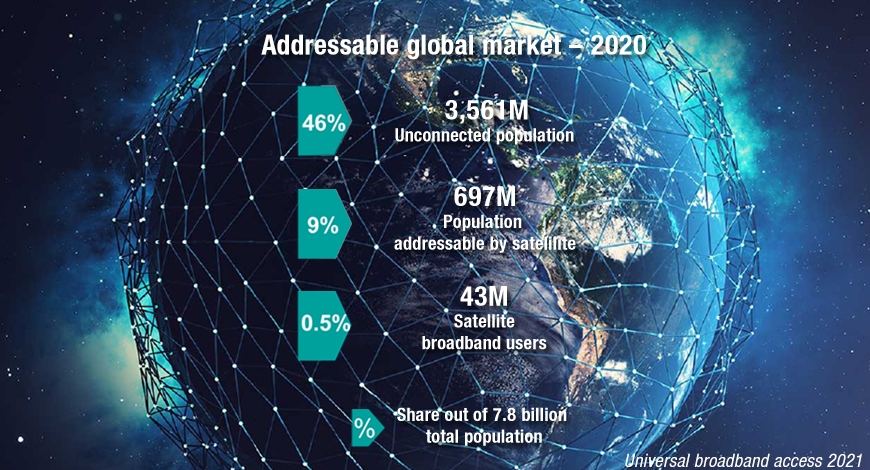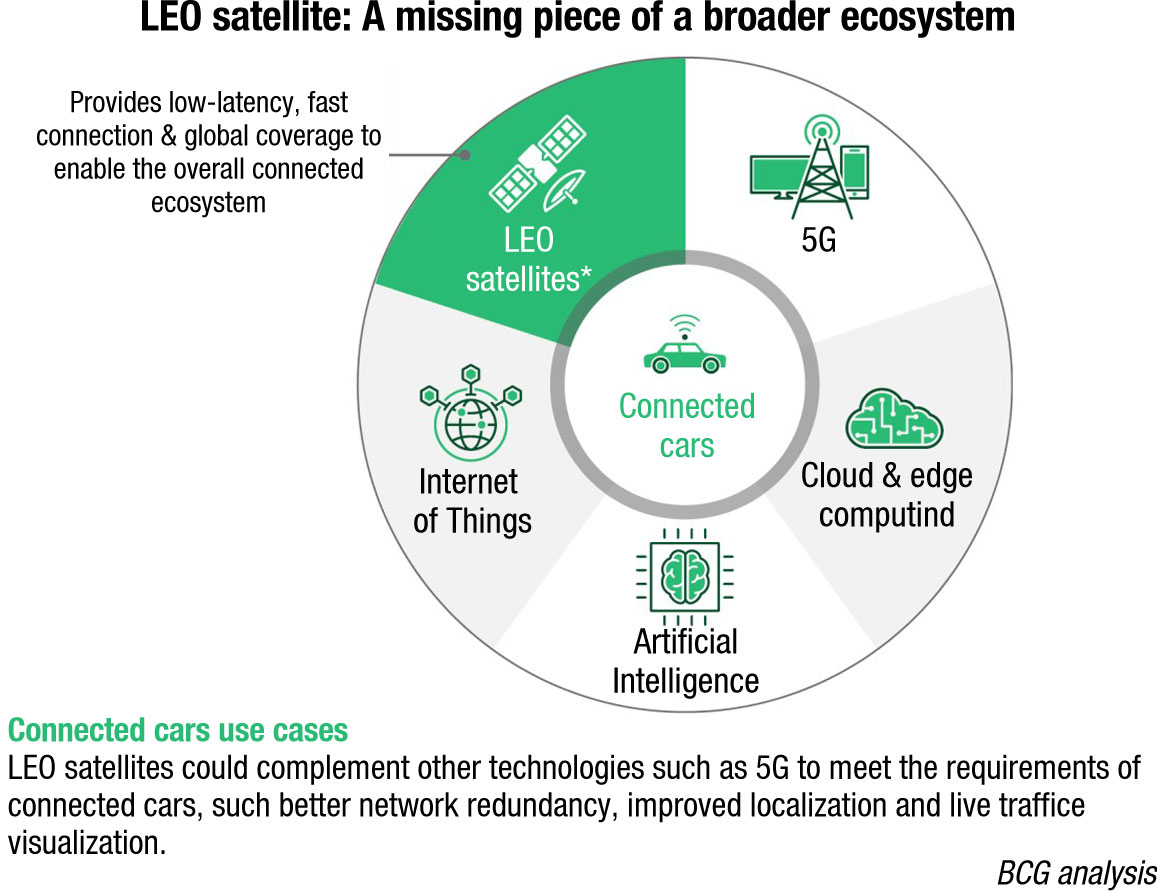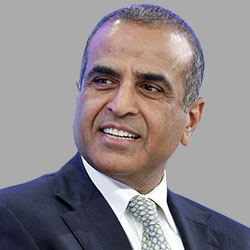5G Features
Rebuilding Internet in space

The Indian satellite communications industry is in a disruptive phase. Ever since Sunil Mittal announced his group’s entry into this space, there is an excitement in the air. Bharti Global promises to connect every square inch of the country by mid-2022. Starlink has announced its presence in India, offering connectivity for USD 99 per month. And the tussle for the 27.5 GHz-29.5 GHz frequency is at an all time high.
Globally too, companies are placing satellites into orbit at an unprecedented frequency to build mega-constellations of communications satellites in low-earth orbit (LEO). In two years, the number of active and defunct satellites in LEO has increased by over 50 percent to about 5000 (March 30, 2021).
In May 2021 itself, SpaceX launched 172 Starlink satellites in just three launches. Bharti Enterprise-owned OneWeb, with its recent launch of 36 satellites, has taken its in-orbit constellation to 218 satellites. These would be a part of OneWeb’s 648 LEO satellite fleet by next year. Kuiper, a subsidiary of Amazon is seeking FCC support to operate systems comprising 3236 satellites. Lightspeed, from Canadian company Telesat will start launching its new constellation of 298 low-earth-orbit broadband satellites in 2023, and plans to have full coverage of the globe by 2024. They currently have almost thirty satellites in orbit, and in 2020, they brought in revenue amounting to USD 820 million. Kepler, a Canadian startup, has tested its prototypes, and plans to launch 140 satellites. China announced it intends to launch its own network of 10,000 low-earth-orbit satellites. China has three projects underway – Hongyun, Hongyan, and Galaxy Space – but little is known about them. The European Union is also planning to set up a network of satellites, with Airbus leading the effort.
OneWeb has a constellation of 648 LEO satellites. In November 2020, a consortium of UK Government and Bharti Global invested USD 1 billion of new equity and rescued OneWeb from US Chapter 11 bankruptcy petition. On December 18, 2020 Arianespace launched 36 OneWeb constellation satellites, bringing the total in-orbit constellation to 110 satellites. In June 2021, Bharti announced an additional investment of USD 500 million and Eutelsat of USD 550 million into the company. On completion of the Call Option in the second half of 2021, Bharti will hold 38.6 percent and the UK Government, Eutelsat, and Softbank will each own 19.3 percent and OneWeb will have secured USD 2.4 billion of equity investment, with no issued debt. The overall cost of putting all the satellites in orbit is estimated between USD 5.45 billion and USD 7 billion. OneWeb is planning a second generation of satellites that may include upgraded technology, such as GPS-like positioning. That second phase will need an additional USD 2 billion to USD 2.5 billion of capital in two to three years’ time.
OneWeb seems to have an edge over the other aggressive players, SpaceX, Telesat and Amazon. The company needed to raise USD 2.3 billion, and has managed to secure USD 2.4 billion in the cart. It is fully funded and is debt-free.
One fundamental difference is the orbits. OneWeb is placing its satellites at 1200 km (in contrast to Starlink’s at 450 km). The closer the satellites are to the earth, the more number of satellites are required. Against OneWeb’s 648 satellites, Starlink will need at least 6000 to 7000 satellites to do the same job. That is more launches and more satellites. Also, OneWeb benefited from USD 3.4 billion of pre-Chapter 11 investment by the original shareholders, making new OneWeb a three-times lower cost constellation.
It has spectrum priority all over the globe, which means other companies which are setting up LEO constellations will have to coordinate with OneWeb and ensure there is no interference in OneWeb’s network. That is a huge advantage in space. The US is one country where both SpaceX and OneWeb have equal priority. Rest of the world OneWeb has the highest priority, then SpaceX and then of course Amazon, Telesat and all others. India being a signatory to ITU, along with other countries, has an agreed plan on spectrum. India is part of that spectrum priority.
The Bharti group also sees its ability to offer an end-to-end solution a major advantage.
With 250,000 cell sites, over a million radio base stations and now 648 towers in space, the service provider will not only be covering the entire globe including Sub-Saharan Africa, deserts of Thar in Rajasthan, deep forests of Madhya Pradesh, the Himalayas, entire coastal area, and aircrafts, but also offer a one single solution to say, a customer who has rural installations as depots, warehouses, and factories that need connectivity with his offices in Mumbai and other major cities.
The company is currently in talks with the Indian Space Research Organisation (ISRO) and other authorities. It is applying for landing rights, permissions, and setting up ground stations in India. It would like ISRO to launch at least one batch of OneWeb satellites. The agency’s commercial arm NSIL could help to manufacture the network’s low-cost ground terminals. It plans to operate two satellite gateways in India, and currently operates gateways globally on the Ka, 28 GHz band. Under the current satcom policy rules, a VSAT services permit holder needs to establish satellite earth station gateways in India for law enforcement purposes, and needs approval from the Department of Space (DoS) to use satellite frequencies. There is no separate license for gateway operations alone. Establishing gateways is part of a VSAT license.



In India, the company expects to sell most of the capacity in one year. The contracts will be with mobile operators, defense authorities, forest department, railways, and shipping agencies. Lots of discussions are currently underway. Since the pricing for satellite services is bound to be expensive, OneWeb is not looking for millions of customers. As part of its strategy, OneWeb will not serve retail customers directly but through partnerships with mobile operators. “Our main customers will be operators, but we will sell ourselves to big enterprises. There will be mix and match, but we are not going to retail customers that is only led by mobile operators. Our design of network is such that we are only serving B2B and we have no ambitions to sell directly to customers. This partnership is open to all operators in the country, we would love to give it to Reliance Jio, and Vodafone Idea,” said Sunil Mittal, Executive Chairman, OneWeb, at one of the press meets. “OneWeb’s goal is to bring connectivity to everywhere where fiber cannot reach, delivering high-speed, low-latency connectivity services to a wide range of customer sectors,” he added.
Starlink has a formidable lead over OneWeb. Since December 2020, when SpaceX bagged USD 886 million from the Federal Communications Commission to deliver high-speed internet to rural parts of the US, the company has gone into a hyperdrive.
Starlink has over 1500 satellites in space; the goal is to have up to 42,000 satellites in orbit by mid-2027, but for now, the company has permission to launch just 12,000. The company is close to launching satellite 1.5 which has laser inter-satellite links, that will be used especially for continuous connectivity over the Arctic and the Antarctic regions. Next year, the company plans to launch version 2.0 of the satellite that will be significantly more capable. All satellites from 1.5 onward will have major satellite links, and the gateways and points-of-presence will ensure that the data goes directly from the user terminal directly to the server center, flowing in the shortest path possible, minimizing latency in general, so that even if big chunks of the internet go down, the connectivity is not lost.
 Elon Musk
Elon Musk
CEO
SpaceX
“A few years back, I was asked what my goal for Starlink was and I had said, not to go bankrupt. Every other LEO communications constellation ever done till now has gone bankrupt. Some of them have emerged from bankruptcy, but the original owners did not benefit from those constellations. Most of them went bankrupt before deploying their constellation fully and even the ones that did deploy their constellation, saw it go through bankruptcy. Companies like Iridium and Orbcomm are doing reasonably well today, but not for the original owners. So, step number one for Starlink is not to go bankrupt.
But from a technology standpoint, Starlink is quite different from prior Leo constellations in that the technology it deploys is very advanced. Each Starlink satellite communicates with four other satellites using lasers. They beam data across the globe at almost the speed of light, and its self-pointing, phased-array antennae maintain a connection as a succession of Starlink satellites pass overhead.”
 Sunil Mittal
Sunil Mittal
Chairman
Bharti Enterprises
“Satellite broadband spectrum should not be allocated through auctions but given administratively. World over, there has never been an auction for satellite spectrum. There is probably lack of understanding …auction what? This is going to be a ground station in let’s say 50 sq km of area, so what you want to auction in a village for 50 sq km…what auction will you do? People do not understand, this is not terrestrial spectrum being used, this is not being used in all parts of the country, this will only be used in two landing stations.
It’s not new, spectrum for satellites has been out there for 100 years and all the GEO/MEO satellites are already using it.”
The combined power of all the 1500 satellites is over five megawatts, capable of outputting 30 terabytes per second of data, and by August 2021 set to have global connectivity everywhere except on the poles. Originally meant for sparsely populated regions, they are well suited to low to medium density areas (not too-high density areas). The service provider mid-June 2021 passed the strategically notable number of 69,420 active users and is on to possibly over 500,000 users within 12 months. Now operational in about 12 countries, the company has changed its strategy from competing with mobile operators to being useful to them for data backhaul, and with latency down under 20 milliseconds there is no lag now.
Now that the company has decided to be complementary to 5G and fiber, it has already two significant partnerships with telcos of a major country and is in dialog with a number of other telcos. This is particularly useful where the telco to receive a 5G license has an obligation for providing rural coverage that makes no economic sense.
Starlink is offering Indian customers to pre-book its broadband offering for USD 99. The kit including a terminal to connect to the satellites, a mounting tripod, a Wi-Fi router and some cables is priced at USD 499. It has faced its first challenge in India. Broadband India Forum, which represents Amazon, Facebook, Google, Microsoft and Hughes, has approached the Telecom Regulatory Authority of India that SpaceX lacks the permissions to offer such services in India, it does not have a license from the DoT (which means they would require a suitable license within or a suitable authorization within the unified license).
The economics are daunting nonetheless. Musk has said Starlink could serve less than 5 percent of internet users and still generate USD 30 billion a year in revenue. Critics called that wishful thinking. OneWeb expects to be close to profitability after 24 months, i.e., by December 2022.
“Is the demand there for tens of millions of subscribers at that price point? In most parts of the world, if you said to someone, your broadband service will cost you USD 100 a month, they’d be like, incredulous. There might be wealthy people in isolated areas, but there’s just not very many of those people,” said analyst Tim Farrar, president at TMF Associates, at a webinar.
Starlink would also struggle for enough capacity to support that level of demand, especially as people are consuming more data for video streaming. That would mean significant additional expenditure on upgrading the satellites and adding more satellites. Perhaps more importantly, Starlink can drive costs down by building its own terminals and satellites. It has hired engineers from chipmakers Broadcom Inc., Qualcomm Inc., and others to design its own communications chips, an approach similar to that taken by Tesla. Starlink has more than halved the terminal cost from USD 3000 and expects it to be in a range of a few hundred dollars within the next year or two. Starlink also benefits from SpaceX’s low-cost launch capability.
 Subba Rao Pavulur
Subba Rao Pavulur
President SIA-India and CMD
Ananth Technologies
“An urgent re-look at deregulation and privatization is required. Advanced space-faring nations have privatized most of these blocks in the value chain. There is a need for building systems to help nurture the industry and create an extensive ecosystem to generate a Space 2.0 in India.
There is massive potential for the space sector in replicating the success of the IT sector, whereby a structured operating system offers opportunities created by the government for larger private sector participation. Armed with a strong regulator and arbitrator, the sector will evolve into a revenue and employment generating behemoth.”
The ambitions for the large LEO concepts may recall the 1990s, when several companies tried to provide global connectivity. Globalstar, Iridium, Odyssey, and Teledesic had impressive plans. In the end, however, all but Iridium scaled back or cancelled their intended constellations because of high costs and limited demand. All suffered financial problems. After that experience, many industry analysts and investors remain skeptical about the viability of large LEO constellations. The recent failures of LeoSat and OneWeb reinforce that impression. “SpaceX, Amazon, and a number of others have created quite a race that no one is absolutely sure whether there is a big enough market for it,” says Matthew J. Desch, Chief Executive Officer, Iridium World Communications.
But much has changed over the past 20 years, says a McKinsey study. Satellite technology has advanced; demand for bandwidth has soared, with no slowdown in sight; and companies have developed creative business models to generate profits from connectivity. Moreover, both tech companies and investors now have much larger stores of capital to invest, making it possible to fund large constellations – although this capital clearly does not have infinite patience.
Our analysis, however, indicates that companies planning large LEO satellite internet constellations still need to reduce a range of costs significantly to ensure long-term viability. Lowering launch costs is one part of the equations, but it will be equally or more critical to reduce the cost of manufacturing spacecraft, ground equipment, and user equipment. If suppliers and constellation providers can achieve these cuts, they could unlock enough demand for large LEO constellations to transform both the B2C and B2B communications markets.
The COVID-19 pandemic will also influence the satellite market’s future, and as of the date it is hard to say how great the impact will be. In the near term, any company that tries to secure funding will face challenges because of economic uncertainty and immediate public-health concerns. These challenges will affect the progress of the remaining licensed concepts – Kuiper, Starlink, and Telesat – differently because their ownership and funding approaches vary.
While physical distancing and work-from-home measures remain in place, the development, manufacture, and launch of large LEO satellites will slow. But the crisis has also caused a spike in demand for internet connectivity and underscored its importance. Investment in any kind of new connectivity infrastructure will be expensive but will almost certainly be needed. Going forward, large LEO concepts could play an important role in meeting this increased demand.
The new LEO-satellite concepts, which orbit 500 to 2,000 kilometers from Earth, offer faster communications (they have lower latency) and often provide higher bandwidth per user than GEO satellites do – even more than cable, copper, and pre-5G fixed wireless. Communication occurs through a constellation of LEO satellites; global coverage requires a large number of spacecraft. These concepts will require major changes in satellite operations, including manufacturing and the supply chain, since they ask more of a satellite and shorten its average life span (estimated to be about five years with Starlink, the SpaceX constellation, for example).
Other issues facing satellite providers. Despite the high costs, we expect that companies with access to funding will remain committed to launching and extending their large low-earth-orbit (LEO) constellations in the near future. After all, first movers get many advantages, including the chance to shape regulations in their favor and the ability to attract early customers. They could also lock in customers, such as airlines, that would have large switching costs. The path forward presents many obstacles besides costs, however. Constellation providers will also need to address the following issues to succeed:
- Better constellation management. Providers that launch hundreds or thousands of satellites need exceptional control and monitoring systems. Even if cost were not a factor, they would still need to develop highly automated solutions to manage this number of systems effectively.
- Regulatory developments. If companies wish to operate in multiple markets, they must address landing rights – the ability to operate in a specific country. The potential for electromagnetic interference (and the resulting liability) is also an area where rules are not yet clear. Once regulators and providers have more clarity, there could be more operating restrictions or additional costs.
- Debris management. Even if companies adhere to plans to remove satellites at the end of their life spans, the amount of space debris could increase because of early failures and loss of control. Companies should thus investigate solutions for removing satellites that fail unexpectedly.
- Competition. The market is unlikely to accept a new competitor passively. Existing satellite-communications providers, with large capital costs already invested, could try to lower prices. They will certainly work to lock in business customers, such as airlines, before the large LEOs can be deployed. On the consumer side, cable and telecom internet service providers will no doubt not only offer lower prices and other incentives, but also make an all-out marketing push to retain customers. The large LEO providers must, therefore, demonstrate that they can compete on service and reliability as well as price.

TV Ramachandran
President
Broadband India Forum
“World over, satellite spectrum is authorized for a right-to-use by all administrations everywhere, and is allocated only by administrative process at charges essentially covering the cost of administration. Unlike terrestrial spectrum, satellite spectrum is never exclusively assigned to the operator but coordinated internationally, and shared among multiple operators for different orbital slots and all types of satellites. Thus, the terrestrial concept of exclusivity does not apply and auctioning therefore not applicable,”
How can large LEO-constellation providers unlock demand by making their prices competitive with terrestrial solutions? The answer is significantly reducing costs, from manufacturing to launch to user equipment – a difficult undertaking that will require close cooperation with suppliers. Of course, there are other obstacles, but cost is the greatest challenge to profitability and long-term viability.
For the stars to align so that large LEO constellations are deployable, one critical factor stands out: cost reductions across the value chain, from satellite manufacturing through launch and operations. Space operations have never previously occurred on this scale, and the manufacturers and suppliers of both space and ground equipment may find it challenging to meet ambitious cost-reduction and performance targets. If these companies succeed, however, they could serve a burgeoning market. The new constellations would add tens of billions of dollars of economic activity to satellite manufacturing, operations, launch, and consumer equipment. Simultaneously, more consumers will have access to internet connectivity. Together, these benefits should encourage providers of satellite components to persevere.













You must be logged in to post a comment Login